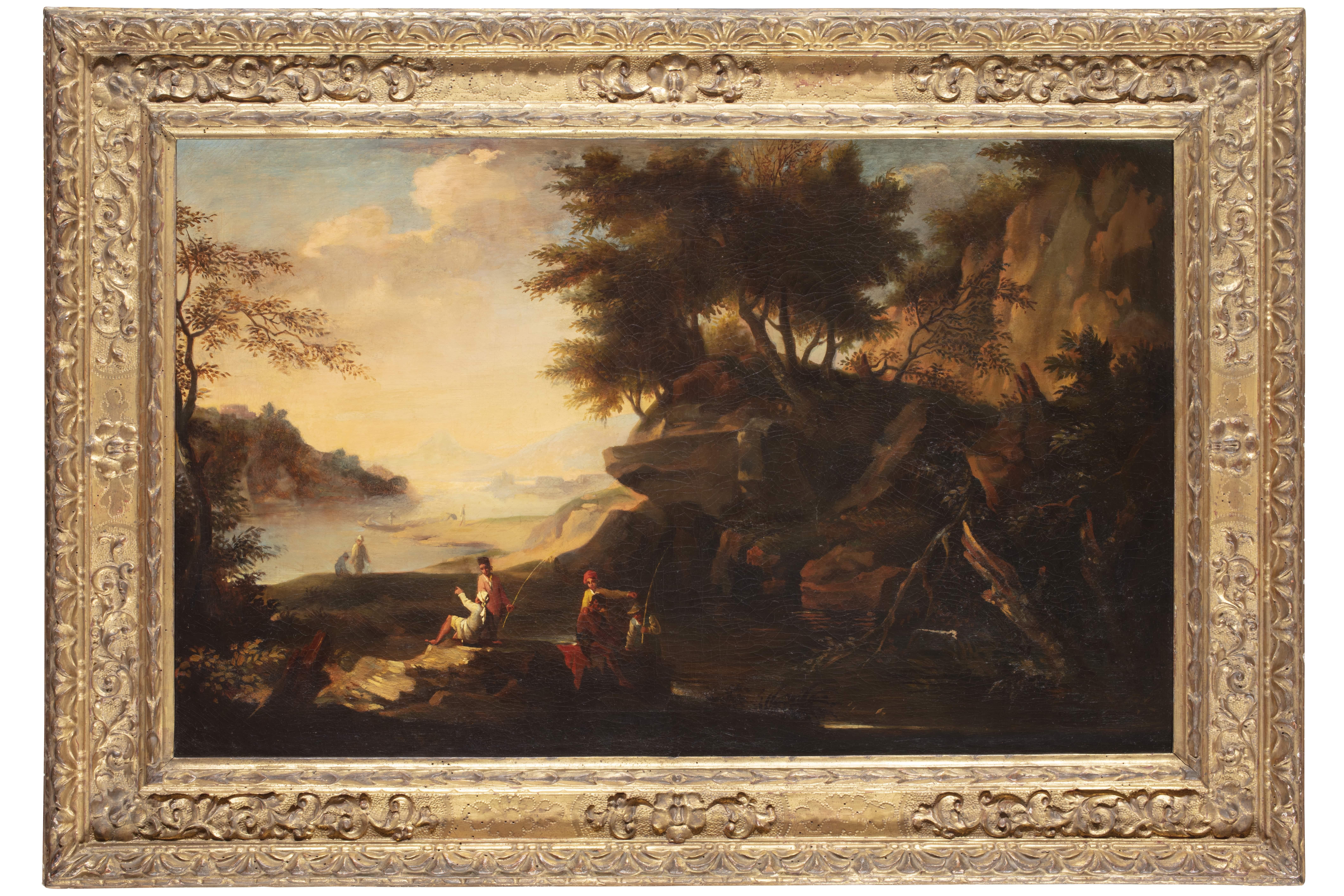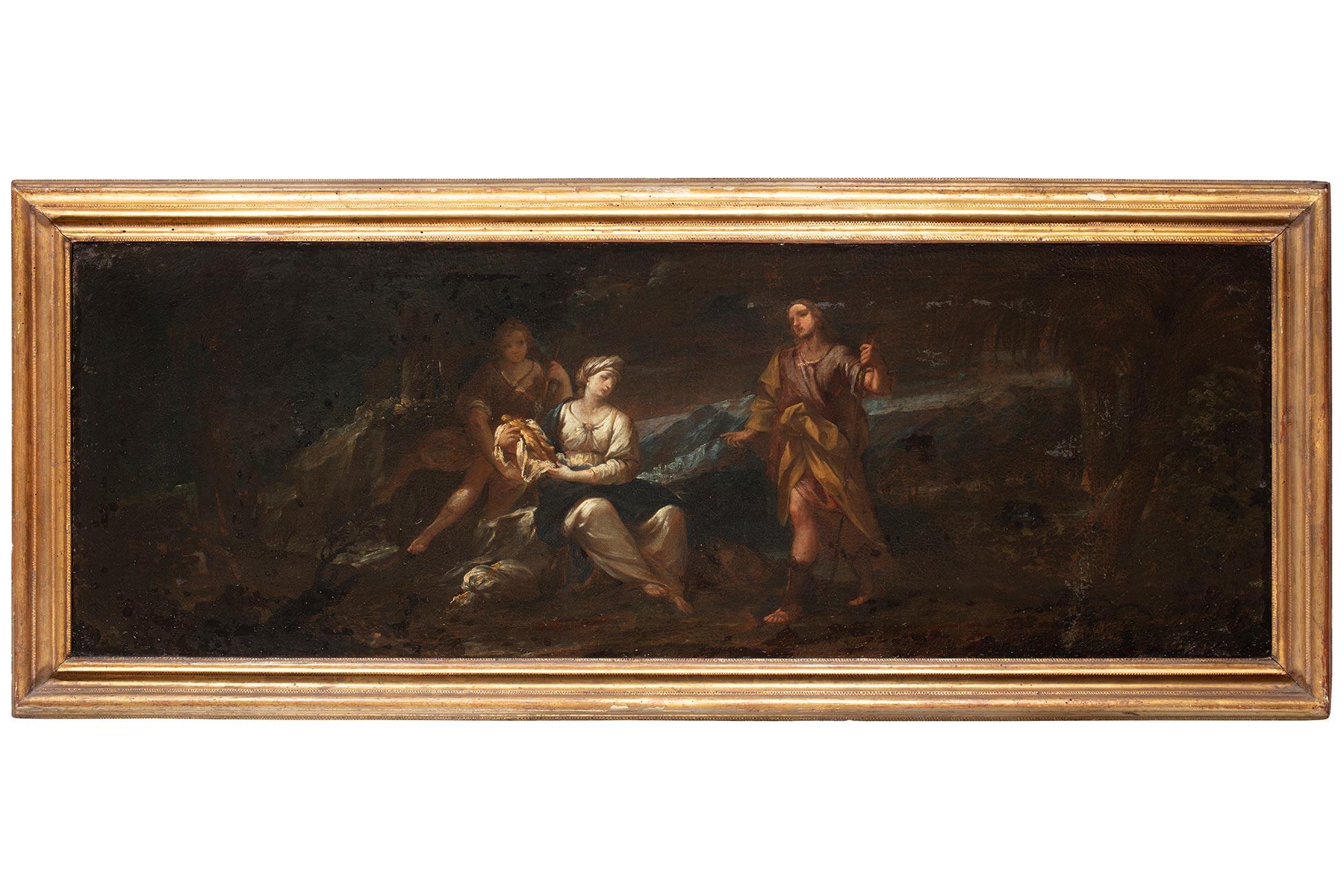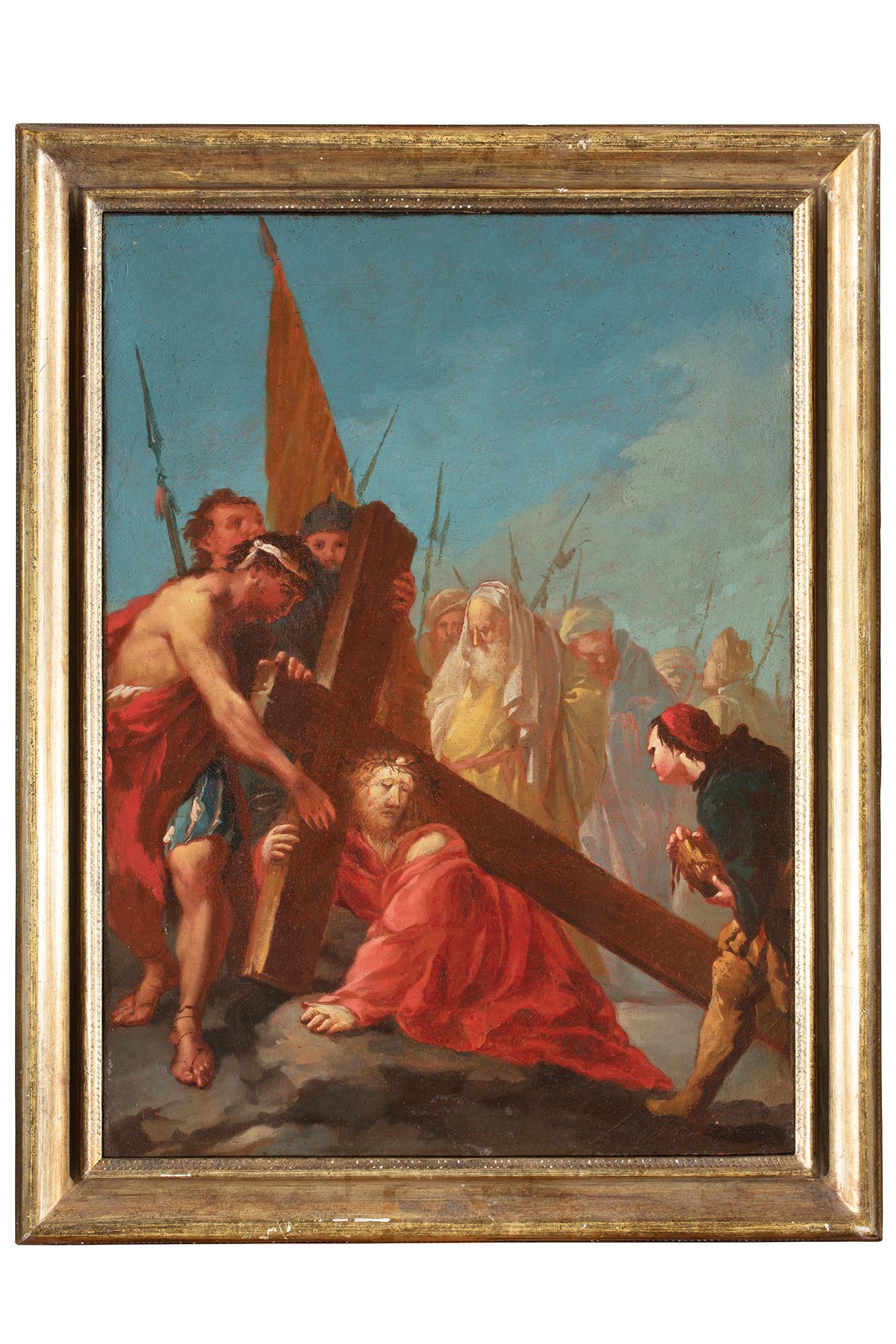Items Similar to The Arrival of the Storm, a painting by the school of Claude-Joseph Vernet
Want more images or videos?
Request additional images or videos from the seller
1 of 16
The Arrival of the Storm, a painting by the school of Claude-Joseph Vernet 1770-1780
1770-1780
About the Item
During his stay in Italy from 1734 to 1752, Joseph Vernet made several trips to Naples between 1737 and 1746, where he painted numerous maritime scenes. The present painting, probably produced in his studio around 1770-1780, takes elements from some of these Neapolitan paintings, introducing an atmospheric element (the arrival of a thunderstorm), which gives this landscape a particular dynamism and pre-romantic tone.
1. Joseph Vernet, a painter under the influence of Italy
Born in Avignon in 1714, Joseph Vernet was trained in the studio of his father, a decorative painter, and in that of Philippe Sauvan (1697 - 1792), a renowned painter from Avignon. In 1734 he left for Rome where he frequented the studios of Bernardino Fergioni (1674 - 1738) and Adrien Manglard (1695-1760), two marine painters. During his stay in Rome, punctuated by trips to the Naples region, Vernet was greatly influenced by the discovery of the works of Claude Lorrain and Salvador Rosa and by the paintings of Giovanni Paolo Panini (1691-1765), whose workshop he probably also frequented in Rome.
It was during his Italian period that Vernet specialised in marine paintings. He quickly became successful with the aristocratic clientele of the Grand Tour, as his livre de raison demonstrates.
He was called back to Paris in 1753 for an important royal commission: the representation of the Ports of France. These paintings, which are mostly kept today in the Musée de la Marine in Paris, are his best-known works. Accepted at the Royal Academy, the memories and the drawings brought back from Italy formed the basis from which he continuously developed the same themes until his death in 1789. He adopted after his return to France a different technique for his maritime landscapes, as if they were painted on porcelain, while perfecting the rendering of light and the effects of mist that made his reputation.
After his return to France, the success of Vernet’s paintings and the importance of the orders he received led to the development of a large workshop in which numerous paintings inspired by the Master's compositions were produced. The two figures advancing in the foreground on the strike to the right of our painting may evoke the works of one of his pupils, Jean-Baptiste François Génillion (Paris 1750 - 1829), who frequented Vernet's studio before taking part in the Salons de la correspondance of 1779, 1781, 1782 and 1783, then in those of the Palais du Louvre from 1791 to 1819.
2. Description of the painting
In this painting the artist combines several points of interest to compose a vivid picture, quivering in the wind as the storm breaks and the rain comes ashore. On the left of the painting a group of elegant visitors examine the fish offered to them by three fishermen. This group is violently illuminated by a last burst of sunlight, while the horizon is darkening and the first lightning bolts begin to flash.
Two other fishermen are hauling in their nets on the right, while a man and a woman are hurrying from the shore as the storm rumbles by; their walk on the rocks, which are probably slippery, seems hazardous. A fisherman's boat in the background is hurrying to land. The rather different execution between the elegant company on the left and the two figures on the shore suggests the participation of different painters, as was often the case for studio works.
A final group of field workers stand at the foot of the wall that protects the pier. Unaffected by the impending storm, they pursue their farming works, digging and cutting weeds for burning. But the highlight of the painting is the depiction of the storm and the lightning that pierces the heavy sky of this warm late afternoon.
3. Related artworks
The group of elegant visitors can already be seen in Vernet's View of a Bay near Naples, painted in 1740 and now conserved at Apsley House (London - UK). The composition is also inspired by other architectural elements typical of the Neapolitan coast, such as the important complex of the mole and the Saint-Vincent tower (shown below in a painting by Antonio Joli), from which the central structure of our painting is probably inspired.
This lighthouse, depicted with a square section and not a round one as the monument in Naples, became a recurring element in Vernet's pictorial output. We find this lighthouse perched atop a rocky hill, for example, in Le Fanal exhaussé, a 1746 painting now in the Musée d'Art et d'Histoire de Genève.
The topographical layout depicted in our painting is echoed in Tempête sur le phare (Storm at the Lighthouse), a painting by Joseph Vernet's studio (now in the Musée des Beaux-Arts de Nantes), which is also thought to have been produced around 1770 - 1780. It is interesting to note that the dimensions of this canvas (82 x 133.8 cm) are very close to those of our painting (79 x 132 cm).
This painting leads us to emphasise the pictorial quality of the representation of the landscape in the background of our painting. To illustrate this, we have compared two parts of the paintings (the left part with the lighthouse and the lightning bolt and the right part with the fort and the hill in the background). We have presented them side by side, with the painting from the Nantes Museum on the left and the one we propose on the right.
This detail of the lighthouse allows us to appreciate the quality of the atmospheric rendering in our painting, particularly through the modulations of the sky crossed by the rain waves. The description of the jetty's architecture is also more picturesque (crenellations on the walls, lantern on the roof), and the modulations of the jetty wall are livelier. The artist plays with different planes (a crenellated section, a recessed walled gateway, a fort crowned with a watchtower) and inserts delightful details (such as the coat of arms on the edge of the fort wall, which does not appear in the Nantes painting).
4. Framing
At the end of the 19th century, this painting was pasted on a new canvas and framed in the gilded Salvador Rosa frame in which we present it today.
Main bibliographic references :
Léon Lagrange - Joseph Vernet - Didier & Cie 1864
Florence Ingersoll-Smouse - Joseph Vernet, Peintre de Marine - Etienne Bignou 1926
Catalogue of the exhibition Joseph Vernet 1714 - 1789 - Musée de la Marine in Paris (from 15 October 1976 to 9 January 1977)
Emilie Beck Saiello - Napoli e la Francia - I Pittori da paesaggio da Vernet a Valenciennes - L'erma di Bretschneider, Roma 2010
- Creation Year:1770-1780
- Dimensions:Height: 37 in (93.98 cm)Width: 57.13 in (145.12 cm)
- Medium:
- Movement & Style:
- Circle Of:Claude-Joseph Vernet (1714 - 1789, French)
- Period:1770-1779
- Condition:31 1/8” x 52 “ (79 x 132 cm) - Framed : 37” x 57 7/8” (94 x 147 cm) Salvador Rosa gilded wood frame.
- Gallery Location:PARIS, FR
- Reference Number:1stDibs: LU1568213166832
About the Seller
5.0
Vetted Seller
These experienced sellers undergo a comprehensive evaluation by our team of in-house experts.
Established in 2020
1stDibs seller since 2021
8 sales on 1stDibs
Typical response time: 2 hours
- ShippingRetrieving quote...Ships From: PARIS, France
- Return PolicyA return for this item may be initiated within 3 days of delivery.
More From This SellerView All
- View of the Grand Canal, a painting by William James, after CanalettoBy William JamesLocated in PARIS, FRAlthough we have little bibliographical information on William James, we know that he was trained by Canaletto during the painter's stay in England between 1746 and 1755. Although he may never have been to Venice, William James remained under the influence of his master for a long time and became known for his paintings inspired by Canaletto's artworks. In this painting, William James is inspired by one of the twelve views of the Grand Canal painted by Canaletto for Joseph Smith, or more precisely by the engraving made by Antonio Visentini in 1735 after this painting. He delivers a very personal version, vibrant with colours, in which he brilliantly reproduces the moving surface of the sea, animated by the ever-changing traffic of the gondolas. 1. William James, the English follower...Category
Mid-18th Century Old Masters Landscape Paintings
MaterialsOil, Canvas
- The Parade of Swiss Guards a painting on canvas by Gabriel de Saint-AubinLocated in PARIS, FRIn this painting, Gabriel de Saint-Aubin, the great chronicler of the reign of Louis XV, takes us to the annual parade of the Swiss Guards at the Plaine de...Category
1760s Old Masters Figurative Paintings
MaterialsCanvas, Oil
- Italian Landscape with Jack Players, a painting by Gaspard Dughet (1615 - 1675)By Gaspard DughetLocated in PARIS, FRHere Gaspard Dughet offers us an idyllic vision of the Roman countryside. The stages follow one another in a perfectly structured composition, revealing here a lake, there travellers walking along, gradually leading our eye to the blue horizon. But behind its classical composition, this landscape is particularly interesting because of three anthropomorphic details that the artist has hidden, opening the way to a radically different interpretation... 1. Gaspard Dughet, a landscape artist in the light of Poussin Gaspard Dughet was born on June 4th, 1615 in Rome where his father, of French origin, was a pastry cook. He was probably named Gaspard in honour of his godfather Baron Gaspard de Morant, who was, or may have been, his father's employer. His older sister Jeanne married the painter Nicolas Poussin (1594 - 1655) on September 1st, 1630. The young Gaspard was apprenticed with his brother-in-law at the beginning of 1631, which led his entourage to name him Gaspard Poussin. The first preserved works of the painter date from the years 1633-1634 and were painted in Poussin’s studio. Around 1635, Gaspard Dughet became emancipated and began to frequent the Bamboccianti circle. In 1636, he became friends with the painter Jean Miel (1599 - 1656), but also with Pier Francesco Mola (1612 - 1666) and Pietro da Cortona (1596 - 1669). This was also the time of his first trips throughout Italy. The painter, although of French origin, appears never to have visited France. In 1646 he settled permanently in Rome. A recognized painter with a solid book of orders, he remained faithful to landscape painting throughout his life, alternating between cabinet paintings and large decorative commissions, using both oil and fresco. Nailed to his bed by rheumatic fever at the age of 58, he died on May 25, 1675. 2. Discovering an idealized landscape Beyond a relatively dark foreground that takes us into the landscape, we discover a vast bluish horizon: a plateau surrounded by deep ravines advances to the right, overhanging an expanse of water that sparkles below. A road winds through a mountainous mass as if leading us to the fortress that crowns it; another town appears in the distance at the foot of three conical mountains. The composition is rigorous, mineral, and structured by geometric volumes. The various stages in the landscape lead one to the next attracting the eye towards the horizon located in the middle of the canvas. The general impression is that of a welcoming and serene nature. In many places the paint layer has shrunk, or become transparent, revealing the dark red preparation with which the canvas was covered and accentuating the contrasts. Human presence is limited to three jack players, leaning against a mound in the foreground. Their long garments, which may evoke Roman togas, contribute to the timelessness of the scene. Close examination of the canvas reveals two other travellers on the path winding between the rocks. Made tiny by the distance, their introduction in the middle register, typical of Dughet's art, lengthens the perspective. While it is difficult to date the work of a painter who devoted his entire life to the representation of landscapes, it is certain that this painting is a work from his later years. The trees that occupied the foreground of his youthful compositions have been relegated to the sides, a stretch of water separates us from the arid mountains counterbalanced by two trees represented on the opposite bank. The introduction of this stretch of water in the middle of the landscape betrays the influence of the Bolognese and in particular of the Dominiquin (1581 - 1641) A number of similarities with a drawing in the British Museum might suggest a date around 1656-1657, since, according to Marie-Nicole Boisclair , it has been compared with the Prado's Landscape with the Repentant Magdalene, painted at that period. 3. Three amazing anthropomorphic details While some late Renaissance landscapes offer a radical double reading, allowing one to see both a face or a human body behind the representation of a landscape, it seems interesting to us to hypothesize that Gaspard Dughet had fun here by slipping in a few details that, taken in isolation, evoke human or animal figures. We will give three examples, looking closely at a cloud, the trunk of a broken tree and the top of a cliff. The main cloud could thus evoke a Christ-like face or that of an antique god...Category
1650s Old Masters Landscape Paintings
MaterialsOil
- Stag Hunting in the Vicinity of Nuremberg by a German Artist Peter von BemmelLocated in PARIS, FRThis small landscape shows a hunting scene: two riders are chasing a stag with their dogs at the edge of a forest. Signed by Peter von Bemmel, it is typical of the production of this...Category
1720s Old Masters Landscape Paintings
MaterialsCopper
- Macbeth and the Three Witches a Painting on Panel by Francesco ZuccarelliBy Francesco ZuccarelliLocated in PARIS, FRThis painting, created during Zuccarelli's stay in England, represents the decisive moment when Macbeth, together with Banquo, meets the three witches who announce that he will be Ki...Category
1760s Old Masters Landscape Paintings
MaterialsOil, Wood Panel
- River Landscape with Shepherds and Architecture, a painting by Jan van BunnikBy Jan van BunnikLocated in PARIS, FRThis painting has been the subject of a study by the art historian Fabrizio Dassie (available on request), confirming its inclusion in Jan van Bunnik’s corpus. In this painting, Ja...Category
Late 17th Century Old Masters Landscape Paintings
MaterialsCopper
You May Also Like
- View of Ponte Milvio in RomeLocated in Roma, RMNorthern painter active in Rome in the second half of the 17th century, View of Ponte Milvio Oil painting on canvas 73 x 97 cm in coeval Roman Salvator Rosa frame.Category
18th Century and Earlier Old Masters Landscape Paintings
MaterialsCanvas, Oil
- 17th Century by Jacob de Heusch Pair of Landscapes Oil on CanvasLocated in Milano, LombardiaDimensions: 50 x 80 cm without frame, 70 x 100 cm with frame. Gilded, carved, sculpted and chiselled wooden box frames. Publications: Jacob de Heusch (1656 – 1701). Un pittore ol...Category
17th Century Old Masters Landscape Paintings
MaterialsCanvas, Oil
- 17th Century by Simone Cantarini Adoration of The Magi Painting Oil on CanvasLocated in Milano, LombardiaSimone Cantarini (Pesaro 1612 - Verona 1648) Adoration of the Magi Oil on paper applied to canvas, cm. 16,5 x 24 – with frame cm. 22 x 29 Antique sh...Category
Early 17th Century Old Masters Figurative Paintings
MaterialsCanvas, Cotton Canvas, Oil
- 17th Century by Felice Torelli Rachel Hiding the Idols Oil on CanvasLocated in Milano, LombardiaFelice Torelli (Verona 1667 - Bologna 1748) Rachel Hiding the Idols Oil on canvas, 41 x 116 cm without frame - 52,5 x 127 cm with frame Original shape...Category
Late 17th Century Old Masters Landscape Paintings
MaterialsCanvas, Cotton Canvas, Oil
- 17th Century by Felice Torelli Hagar and the Angel Oil on CanvasLocated in Milano, LombardiaFelice Torelli (Verona 1667 - Bologna 1748) Hagar and the Angel Oil on canvas, 41 x 116 cm without frame - 52,5 x 127 cm with frame Original shaped and ...Category
Late 17th Century Old Masters Landscape Paintings
MaterialsCanvas, Cotton Canvas, Oil
- 19th Century By Giustino Menescardi Ascent to Calvary Oil on CanvasLocated in Milano, LombardiaGiustino Menescardi (Milan, c. 1720 - Venice, after 1779) Ascent of Calvary Oil on canvas, cm. 47 x 36 - with frame cm. 57x43 Shaped and gilded wooden cassetta frame Publications: Bozzetti, modelletti, sketches: dalla collezione di Giorgio Baratti...Category
Early 18th Century Old Masters Landscape Paintings
MaterialsCotton Canvas, Canvas, Oil




